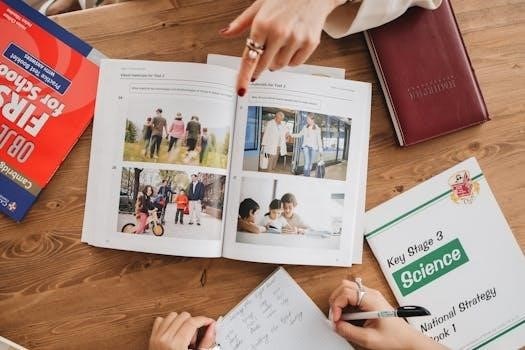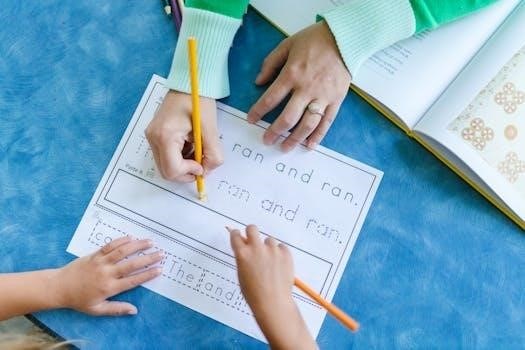
Understanding Guided Reading Activities
Guided reading activities involve small groups working on texts, enhancing comprehension skills. These sessions often incorporate targeted questions, designed to check understanding. The goal is to promote independent reading abilities.
What are Guided Reading Activities?
Guided reading activities are structured sessions where small groups of students engage with a text under the teacher’s guidance. These activities focus on developing reading strategies, comprehension, and vocabulary skills. The teacher facilitates discussions, asks targeted questions, and provides support to students as they read. Often, these activities will include comprehension questions, vocabulary work and analysis of the text. They also encourage active participation, collaboration and the development of independent reading skills. Materials are chosen at appropriate reading levels to promote student success and engagement. These activities are a key component of literacy instruction.

Purpose of Answer Keys
Answer keys provide a reference for checking student understanding in guided reading. They offer correct responses to activity questions. This helps teachers assess student progress and identify areas needing more focus.
Why Answer Keys are Important for Guided Reading
Answer keys are crucial in guided reading as they provide immediate feedback, allowing students to self-assess their comprehension. This instant verification helps clarify misconceptions and reinforces correct understanding. For educators, answer keys offer a standardized method to evaluate student work, ensuring consistency in grading. They also save time, allowing teachers to focus on instruction and provide targeted support to students. Furthermore, they are a valuable tool for lesson planning and curriculum development by showing which areas are more challenging. They help to track progress and ensure learning objectives are met.
Networks in Guided Reading
Networks in guided reading refer to the interconnectedness of ideas within a text. Students explore relationships between concepts, characters, and events, fostering deeper comprehension. This approach promotes critical thinking.
How Networks Relate to Guided Reading Activities
In guided reading, networks emphasize how different elements within a text connect and interact. This can include understanding character motivations, plot developments, and the overall theme. Exploring these networks helps students see the bigger picture and make inferences beyond the literal text. By mapping these connections, students develop a more nuanced understanding of the material. This approach allows them to grasp the interplay of ideas, supporting deeper comprehension and analytical skills. The guided reading activities promote critical thinking skills through networking.
Lesson 2 Specifics
Lesson 2 often focuses on specific content, like early exploration or historical events such as World War II. Activities target particular reading comprehension skills relevant to the lesson’s content.
Focus on ‘Lesson 2’ within Guided Reading
Within guided reading, ‘Lesson 2’ typically builds upon concepts introduced in the first lesson. This might involve exploring specific historical periods, like the impact of railroads or early exploration. The activities often include questions that require students to analyze and synthesize information from the text. The aim is to deepen their understanding of the core ideas presented in the lesson, pushing them towards more complex comprehension. This lesson could also focus on specific vocabulary or skills needed for subsequent lessons.

Common Themes in Lesson 2
Recurring topics in “Lesson 2” often include exploration of historical events, like World War II or the impact of railroads. It also involves analyzing societal changes and adaptations.
Recurring Topics in ‘Lesson 2’ Activities
Within “Lesson 2,” activities frequently explore themes of historical significance, such as World War II, delving into events like the postponed invasion of Britain. Another common theme focuses on the impact of technological advancements, for example, how railroads unified nations or the revolution caused by the automobile. Early explorations and the search for new trade routes are also recurring themes in various lessons. Moreover, the adaptation of people to new environments and the understanding of cause-and-effect relationships also feature in these lesson plans.
Finding Answer Keys Online
Locating answer keys involves searching educational websites, online forums, and document sharing platforms. Specific phrases like “guided reading lesson 2 key” can aid in finding the material needed.
Where to Locate ‘Answer Key Networks Guided Reading Activity Answers Lesson 2’
Finding specific answer keys for “Answer Key Networks Guided Reading Activity Answers Lesson 2” often requires a strategic online search. Begin by using precise keywords in search engines. Explore educational resource sites, which frequently host study guides and answer keys. Check online forums where educators share materials. Additionally, look for file-sharing platforms that might contain relevant documents. Consider exploring digital libraries or academic databases. Remember to verify the reliability of any source before using the answer keys. Specific textbook publisher websites can also be a valuable resource.
Types of Questions in Guided Reading
Guided reading questions vary; some focus on recalling facts, while others promote deeper analysis. Inferential questions and those requiring synthesis are also common, encouraging critical thinking.
Analyzing Question Formats in Activities
Within guided reading, questions often take distinct forms. Some are direct, seeking factual recall, like “What year did the railroad boom begin?” Others are inferential, prompting students to read between the lines. There are also questions that require summarizing, asking students to condense a large amount of information. Comparative questions might ask students to contrast different elements of a text. The diversity in question format promotes a range of cognitive skills and encourages a deeper engagement with the material, thus ensuring comprehension and analytical thinking are improved.

Analyzing Answers in Guided Reading
Correct answers in guided reading indicate comprehension and recall. They show a student’s grasp of key details and concepts. Analyzing wrong answers helps identify areas where students need support.
How to Interpret Correct Answers
Correct answers in guided reading activities signal a student’s successful engagement with the text. These responses demonstrate their ability to extract relevant information. Accurate answers show that students understand the main ideas and supporting details. Furthermore, correct responses indicate the student’s capacity to make connections and inferences. These answers validate their comprehension of specific concepts covered in ‘Lesson 2’. They also show understanding of historical events, such as those related to World War II, or explorations of new territories. Analyzing such answers helps gauge the effectiveness of the lesson.
Using Answer Keys Effectively
Answer keys should be used as a tool for checking understanding, not just providing answers. They aid in identifying areas of student difficulty and guide future teaching.
Best Practices for Utilizing Answer Keys
When using answer keys for guided reading, it’s crucial to focus on the learning process, rather than just the final answers. Review responses with students, discussing the reasoning behind each correct answer and exploring why incorrect answers occurred. Use the answer key to identify common misconceptions and tailor future instruction accordingly. Encourage students to reflect on their thought processes, fostering a deeper understanding of the material. Answer keys should serve as a tool for both assessment and teaching, promoting growth in reading comprehension. Avoid simply giving away answers; instead, prompt critical thinking.

Troubleshooting Common Issues
Difficulties arise when answer keys are unavailable or unclear. Check multiple sources and ensure the key aligns perfectly with the specific activity. Seek clarification when needed.
Addressing Challenges with Finding or Using Answer Keys
Locating the correct answer key for “Lesson 2” can be problematic due to varied content. Sometimes, keys are mislabeled or not specific enough, leading to frustration. Furthermore, some keys might be incomplete, or even incorrect, requiring verification. When using the key, ensure the answers align with the intended learning goals. It’s crucial to interpret answers, rather than simply memorizing them. If problems persist, cross-reference with educational materials. Be sure to consult with educators for guidance on using keys in learning activities.